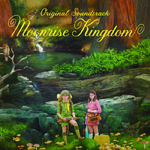The Young Person's Guide To The Orchestra, Op. 34: Themes A-F歌词

歌曲名:The Young Person's Guide To The Orchestra, Op. 34: Themes A-F 歌手:Alexandre Desplat 所属专辑:《Moonrise Kingdom (Original Soundtrack)》
介绍:《The Young Person's Guide To The Orchestra, Op. 34: Themes A-F》是由Alexandre Desplat演唱的歌曲,该歌曲收录在Alexandre Desplat的《Moonrise Kingdom (Original Soundtrack)》专辑之中,如果您觉得该歌曲好听的话,就把这首歌分享给您的朋友一起支持Alexandre Desplat的The Young Person's Guide To The Orchestra, Op. 34: Themes A-F的吧!
The Young Person's Guide To The Orchestra, Op. 34: Themes A-F歌词
In order to show you how a big symphony orchestra is put together,
Benjamin Britten has written a big piece of music,
which is made up of smaller pieces
that show you all the separate parts of the orchestra.
These smaller pieces are called variations,
which means different ways of playing the same tune.
First of all, he lets us hear the tune or the theme,
which is a beautiful melody
by the much older British composer Henry Purcell.
Here is Purcell's theme played by the whole orchestra together.
MUSIC
Now, Mr. Britten lets you hear the four different families of the orchestra
playing the same Purcell theme in different ways.
First, we hear the woodwind family.
The flutes, the oboes, the clarinets and the bassoons.
MUSIC
Here comes the brass family.
The trumpets, the horns, the trombones and the tubas.
MUSIC
Now, Mr. Britten arranges the Purcell theme for the string family.
The violins, the violas, the cellos and the double basses.
And of course, the harp.
MUSIC
And finally the percussion family,
all those drums and gongs and things you hit.
MUSIC
After this, you will hear the theme by Purcell played once more
in its original form by all four families together.
That is, the whole orchestra.
MUSIC
Benjamin Britten has written a big piece of music,
which is made up of smaller pieces
that show you all the separate parts of the orchestra.
These smaller pieces are called variations,
which means different ways of playing the same tune.
First of all, he lets us hear the tune or the theme,
which is a beautiful melody
by the much older British composer Henry Purcell.
Here is Purcell's theme played by the whole orchestra together.
MUSIC
Now, Mr. Britten lets you hear the four different families of the orchestra
playing the same Purcell theme in different ways.
First, we hear the woodwind family.
The flutes, the oboes, the clarinets and the bassoons.
MUSIC
Here comes the brass family.
The trumpets, the horns, the trombones and the tubas.
MUSIC
Now, Mr. Britten arranges the Purcell theme for the string family.
The violins, the violas, the cellos and the double basses.
And of course, the harp.
MUSIC
And finally the percussion family,
all those drums and gongs and things you hit.
MUSIC
After this, you will hear the theme by Purcell played once more
in its original form by all four families together.
That is, the whole orchestra.
MUSIC
The Young Person's Guide To The Orchestra, Op. 34: Themes A-FLRC歌词
[00:00.00]In order to show you how a big symphony orchestra is put together,
[00:05.32]Benjamin Britten has written a big piece of music,
[00:08.80]which is made up of smaller pieces
[00:10.58]that show you all the separate parts of the orchestra.
[00:13.52]These smaller pieces are called variations,
[00:16.47]which means different ways of playing the same tune.
[00:19.61]First of all, he lets us hear the tune or the theme,
[00:23.35]which is a beautiful melody
[00:24.54]by the much older British composer Henry Purcell.
[00:28.02]Here is Purcell's theme played by the whole orchestra together.
[00:31.91]MUSIC
[01:00.67]Now, Mr. Britten lets you hear the four different families of the orchestra
[01:04.49]playing the same Purcell theme in different ways.
[01:07.64]First, we hear the woodwind family.
[01:09.52]The flutes, the oboes, the clarinets and the bassoons.
[01:13.38]MUSIC
[01:35.46]Here comes the brass family.
[01:37.17]The trumpets, the horns, the trombones and the tubas.
[01:43.07]MUSIC
[02:02.61]Now, Mr. Britten arranges the Purcell theme for the string family.
[02:06.16]The violins, the violas, the cellos and the double basses.
[02:10.60]And of course, the harp.
[02:13.94]MUSIC
[02:34.53]And finally the percussion family,
[02:36.42]all those drums and gongs and things you hit.
[02:38.96]MUSIC
[02:42.41]After this, you will hear the theme by Purcell played once more
[02:45.53]in its original form by all four families together.
[02:48.94]That is, the whole orchestra.
[02:57.34]MUSIC
[00:05.32]Benjamin Britten has written a big piece of music,
[00:08.80]which is made up of smaller pieces
[00:10.58]that show you all the separate parts of the orchestra.
[00:13.52]These smaller pieces are called variations,
[00:16.47]which means different ways of playing the same tune.
[00:19.61]First of all, he lets us hear the tune or the theme,
[00:23.35]which is a beautiful melody
[00:24.54]by the much older British composer Henry Purcell.
[00:28.02]Here is Purcell's theme played by the whole orchestra together.
[00:31.91]MUSIC
[01:00.67]Now, Mr. Britten lets you hear the four different families of the orchestra
[01:04.49]playing the same Purcell theme in different ways.
[01:07.64]First, we hear the woodwind family.
[01:09.52]The flutes, the oboes, the clarinets and the bassoons.
[01:13.38]MUSIC
[01:35.46]Here comes the brass family.
[01:37.17]The trumpets, the horns, the trombones and the tubas.
[01:43.07]MUSIC
[02:02.61]Now, Mr. Britten arranges the Purcell theme for the string family.
[02:06.16]The violins, the violas, the cellos and the double basses.
[02:10.60]And of course, the harp.
[02:13.94]MUSIC
[02:34.53]And finally the percussion family,
[02:36.42]all those drums and gongs and things you hit.
[02:38.96]MUSIC
[02:42.41]After this, you will hear the theme by Purcell played once more
[02:45.53]in its original form by all four families together.
[02:48.94]That is, the whole orchestra.
[02:57.34]MUSIC
歌词点击排行榜
最新歌词推荐
最新专辑推荐
最新歌单推荐
- 1『韩语歌』那些让人一秒沦陷的神仙前奏执剑稳
- 2那些你熟悉却又不知道名字的轻音乐Lelow
- 3第44届全英音乐奖‖SZA拿下年度国际艺术家Alimjan_Abdurezak阿力木江
- 4享受当下:要像风一样自由洒脱白鱼暮归
- 5周杰伦歌曲 | 回忆青春 致敬我们曾经的岁月执剑稳
- 6韩语流行热歌:哪首是你的心头好一定会成为富婆的
- 7周杰伦免费听 | 青春 一个人悄无声息的回忆执剑稳
- 8荒诞美学|神秘诡谲°优雅与疯狂Evelauren
- 9少女向R&B:可爱且快乐鼓点 R&B拯救世界~凌晨一点的莱茵猫
- 10高级感拉满|ENTP星人定制韩衣间施绮言
